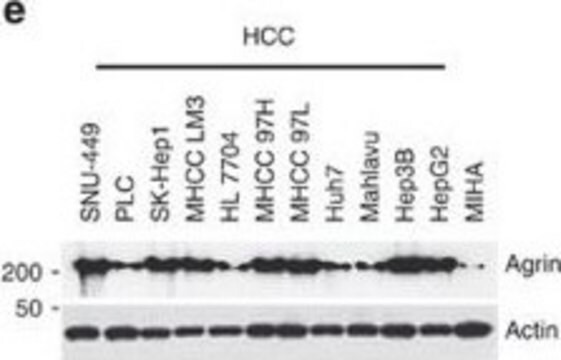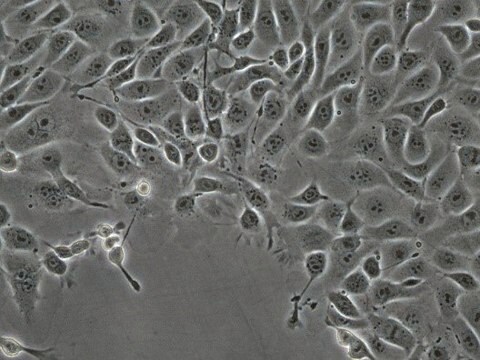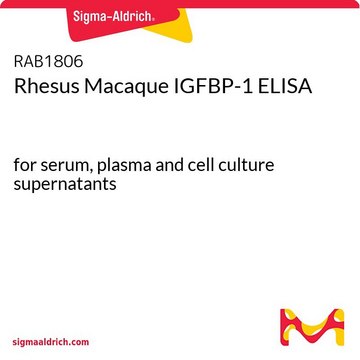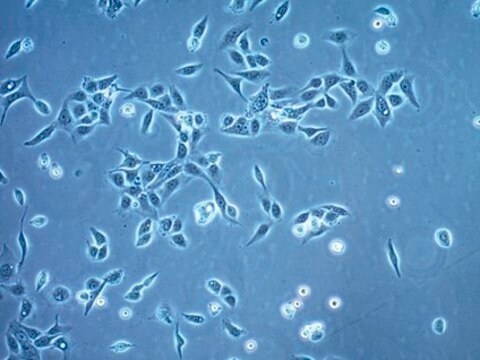Allgemeine Beschreibung
Agrin (UniProt: O00468) is encoded by the AGRN (also known as AGRIN) gene (Gene ID: 375790) in human. Seven different isoforms of agrin have been described that are produced by alternative splicing. This antibody (clone 1H10.1) is raised against isoform 1 and is also known as secreted agrin. This isoform is a heparan sulfate basal lamina glycoprotein that plays a central role in the formation and the maintenance of the neuromuscular junction (NMJ) and directs key events in postsynaptic differentiation. It is a component of the AGRN-LRP4 receptor complex that induces the phosphorylation and activation of MUSK. The activation of MUSK in myotubes induces the formation of NMJ by regulating different processes including the transcription of specific genes and the clustering of acetylcholine receptors (AChR) in the postsynaptic membrane. Calcium ions reported to be essential for maximal AChR clustering. In the central nervous system it inhibits the alpha(3)-subtype of Na+/K+-ATPase and evokes depolarization at CNS synapses. This isoform of agrin forms a bridge, after release from motor neurons, to basal lamina through binding laminin via the N-terminal (NtA) domain. At synaptic junctions, agrin is cleaved at two conserved sites, alpha and beta, by neurotrypsin. Cleavage at the alpha-site produces the agrin N-terminal 110-kDa subunit and the agrin C-terminal 110-kDa subunit. Further cleavage of agrin C-terminal 110-kDa subunit at the beta site produces the C-terminal fragments, agrin C-terminal 90 kDa fragment and agrin C-terminal 22 kDa fragment. The N-terminal (110 kDa) subunit is involved in regulation of neurite outgrowth probably due to the presence of the glycosaminoglcan (GAG) side chains of heparan and chondroitin sulfate attached to the Ser/Thr- and Gly/Ser-rich regions. The C-terminal (22 kDa) fragment is important for agrin signaling and to exert a maximal dendritic filopodia-inducing effect. Excessive cleavage at the beta-site releases large amounts of the 22 kDa fragment that leads to destabilization at the neuromuscular junction.
Spezifität
Clone 1H10.1 detects Agrin in human, mouse, and rat cells. It targets an epitope within 99 amino acids from the C-terminal end.
Immunogen
GST/His-tagged recombinant fragment corresponding to 99 amino acids from the C-terminal region of human Agrin isoform 1.
Anwendung
Research Category
Neurowissenschaft
Anti-Agrin, clone 1H10.1, Cat. No. MABN1205, is a highly specific mouse monoclonal antibody that targets Agrin and has been tested for use in Western Blotting.
Western Blotting Analysis: 1 µg/mL from a representative lot detected Agrin in 10 µg of mouse brain tissue lysate.
Qualität
Evaluated by Western Blotting in rat brain tissue lysate.
Western Blotting Analysis: 1 µg/mL of this antibody detected Agrin in 10 µg of rat brain tissue lysate.
Zielbeschreibung
~220 kDa observed; 217.23 kDa calculated. Uncharacterized bands may be observed in some lysate(s).
Physikalische Form
Protein G purified
Format: Purified
Purified mouse monoclonal antibody IgG2b in buffer containing 0.1 M Tris-Glycine (pH 7.4), 150 mM NaCl with 0.05% sodium azide.
Lagerung und Haltbarkeit
Stable for 1 year at 2-8°C from date of receipt.
Sonstige Hinweise
Concentration: Please refer to lot specific datasheet.
Haftungsausschluss
Unless otherwise stated in our catalog or other company documentation accompanying the product(s), our products are intended for research use only and are not to be used for any other purpose, which includes but is not limited to, unauthorized commercial uses, in vitro diagnostic uses, ex vivo or in vivo therapeutic uses or any type of consumption or application to humans or animals.









